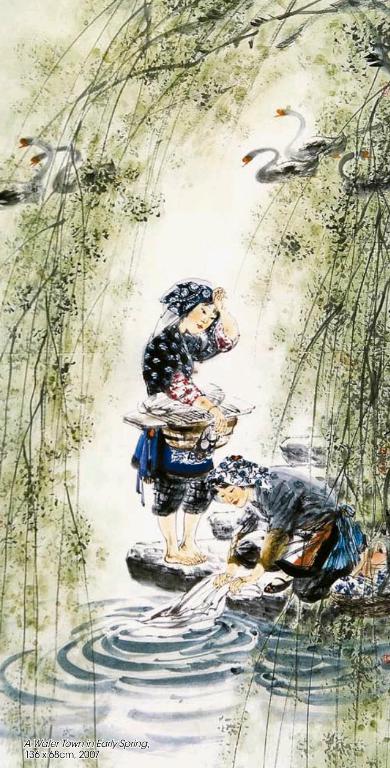Inking Innovation Feng Yuan’s Ink and Wash
2014-03-28byXuEncun
by+Xu+Encun
Throughout the history of paint- ing and even the greater art world, modernism has existed to innovatively evolve practices past existing modes and rules. Initially, breakthroughs may only cause little influence. However, quantitative accumulation will eventually lead to a qualitative leap. This is what has happened to traditional Chinese painting.
Feng Yuans persistent reform of traditional ink and wash painting is a pristine example.
Since the 1980s, based on his in-depth understanding of tradition, Feng has consciously isolated his art from traditional scholarly painting focused on showcasing emotions, broadening his vision by setting sight on the immense real world, which imbues his art with a sense of unmatched magnificence and profundity. He has managed to reawaken the spirit of traditional Chinese culture that advocates the philosophical, unrefined, and immense through persistently reforming traditional painting techniques, thus forming his own artistic language and method of expression.
Feng established his macro integration methods of painting by studying historical epics. He extracts formal beauty, as well as the relations and conversion abilities of black and white, from the casual brushwork of traditional painting. Meanwhile, he absorbs aesthetic elements of Western art, such as shapes, dimensions, and structures. His singular artistic taste and aesthetic ideals have made him stand out from his counterparts.
The most noteworthy, perhaps, is how Feng introduces the concept of rationality to his ink and wash painting. Particularly, his intensification of elements such as philosophy, history, and life makes his work appear more rational and thought-provoking in terms of atmosphere, structure, and art language. Philosophical enlightenment and rational interest have become important aesthetic orientations of his art.
Intuitively, the painters accomplishments in brushwork are reflected in the changing forms and structures of his art language. He has endeavored to remove and eliminate traditional paintings singularity in logical function and symbolic meaning, but seek ambiguous brushwork, possibilities of expression, diversification of meaning, and general aesthetics, so as to give full play to his skill and wisdom.
Feng insists on composing paintings with imagination at the core, which enables him to use techniques freely. He favors image superposition, which helps him increase the ambiguity of his language and explore the aesthetic perceptions of forms. In fact, this is the key to the language mechanism that makes the concept of modernity meet the emotional and spiritual requirements of contemporary people.

Such exquisite expression of human spirit and thought marks a tremendous change for traditional Chinese ink and wash painting. From the perspective of artistic innovation, Fengs art evidences the self-renewal of traditional ink and wash art language enabled by a change of context. With the introduction of rationality, a new ink and wash genre was created, which integrates the spirit of traditional art and the vitality of modern art – imbued with a mixed sense of solemnity and dynamics.
All high-level art reaches for spiritual profundity. Feng has long committed himself to creating spiritually profound art and exploring its connection to history. Spectators cant help but sense the aesthetic broadness and rich spiritual meanings in Fengs work. Obviously, his art is grounded in belief: Throughout the ages, the essence of human culture has differed little between the East and the West, and its eternality transcends time and space. Based on this idea, ink and wash painting should cultivate a generation of artists who not only respect traditional wisdom, but also endeavor for modern innovative spirit.

The magnificent, poetic atmosphere of Fengs ink and wash painting is attributed to his aesthetic expression and poetic brushwork, as well as his rational understanding of life and insight and reverence for human spirit. Great courage and confidence are required to break traditional rules and shake off the chains of classics. Eventually, Feng created a new genre of painting more academic and passionate, which offers enough room for the painter to give full play to his talent. Feng and his art belong to the new century.
